Expert’s Rating
Pros
- High GPU and CPU performance
- Competitive price for the hardware
- Mechanical keyboard
- Lots of high-end touches
Cons
- No HDR for games
- Copilot key is rather large
- “Liquid Teal” color scheme may be divisive
- Low battery life (obviously)
Our Verdict
The Alienware 16 Area-51 delivers serious gaming performance in an excellent package, complete with a mechanical keyboard and other high-end touches. It’s competitively priced for the hardware, too.
Price When Reviewed
This value will show the geolocated pricing text for product undefined
Best Pricing Today
Price When Reviewed
$3,349
Best Prices Today: Alienware 16 Area-51
The Alienware 16 Area-51 is a high-end gaming laptop with a high-end Intel Core Ultra 9 275HX CPU and Nvidia RTX 5080 graphics, which were both just recently released. It’s a beautiful machine with premium touches like a mechanical keyboard. While it’s no budget gaming laptop, it’s competitively priced compared to other laptops with similar hardware — and Alienware’s version may just be a better package.
Alienware 16 Area-51: Specs
The Alienware 16 Area-51 is a 16-inch gaming laptop that combines a 24-core Intel Core Ultra 9 275HX CPU along with an Nvidia RTX 50-series GPU. Our review model had an RTX 5080 GPU, but you can also get this machine with an RTX 5070 Ti or 5090 GPU. While the model we reviewed retails for $3,349, the base model starts at $2,999.
That Intel Core Ultra 9 275HX is worth highlighting! This Core Ultra (Series 2) processor is based on the Arrow Lake architecture and is screaming fast. In our benchmarks, this machine topped out the charts. However, it has a slow neural processing unit (NPU) and doesn’t meet the bar for Windows 11’s Copilot+ PC AI features, if those matter to you. (Unless this is something you know you care about, I wouldn’t worry about it — especially since Microsoft is signaling it may one day roll out these features more widely. But they aren’t here at launch, and that may matter to some people.)
- Model number: Alienware 16 Area-51 AW30
- CPU: Intel Core Ultra 9 275HX
- Memory: 32GB DDR5 RAM
- Graphics/GPU: Nvidia GeForce RTX 5080
- NPU: Intel AI Boost (up to 13 TOPS)
- Display: 16-inch 3200×1800 IPS display with 240Hz refresh rate
- Storage: 1 TB SSD
- Webcam: 8MP 3840×2160 camera
- Connectivity: 2x Thunderbolt 5 (USB Type-C), 3x USB Type-A 3.2 Gen 1 (5 Gbps), 1x HDMI 2.1, 1x combo audio jack, 1x SD card slot
- Networking: Wi-Fi 7, Bluetooth 5.4
- Biometrics: IR camera for Windows Hello
- Battery capacity: 96 Watt-hours
- Dimensions: 14.37 x 11.41 x 1.12 inches
- Weight: 7.49 pounds
- MSRP: $3,349 as tested
This thing looks like it’s about to blast the thrusters and head to outer space.
Alienware 16 Area-51: Design and build quality
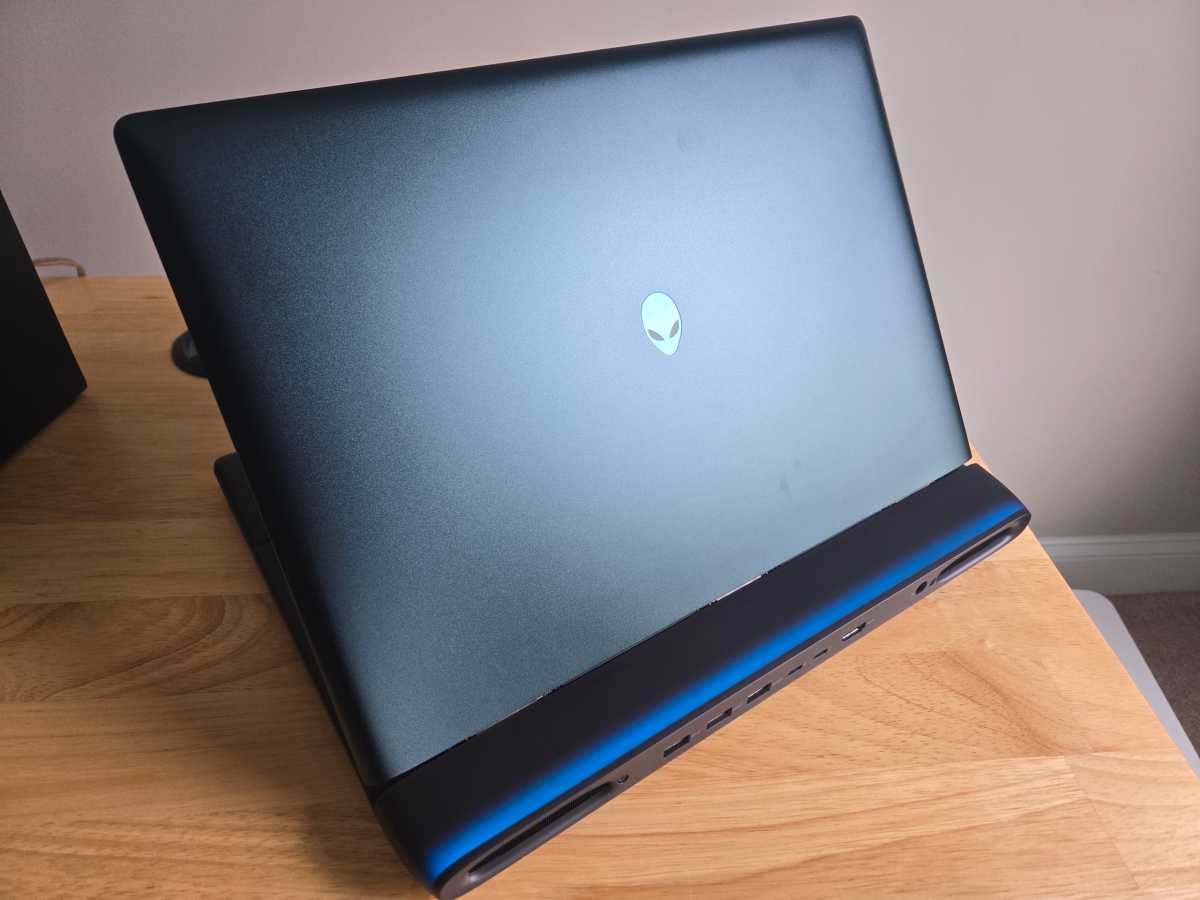
IDG / Chris Hoffman
The Alienware laptops I’ve reviewed have had solid build quality, and this laptop is no exception. The “Liquid Teal” color has a lid that looks a lot like forest green in some lighting. Dell describes it as “a dark iridescent finish on the anodized aluminum [that] gives the system a dynamic sheen.” At about seven and a half pounds, it’s no thin-and-light laptop, but it is very reasonable for a machine this powerful.
With a glowing Alienware logo on the lid, a light bar on the bump at the back, and black used throughout the rest of the machine — including on the keyboard tray and lid, so you aren’t looking at that Liquid Teal all the time — this is very much an Alienware design. I like the look and how the color stands out. It doesn’t look like just another gaming laptop, but you’ll have to decide whether it’s the right look for you. I know not everyone is looking for this type of color scheme, and there’s a reason why so many gaming laptops are a traditional black or a sharp and clean white.
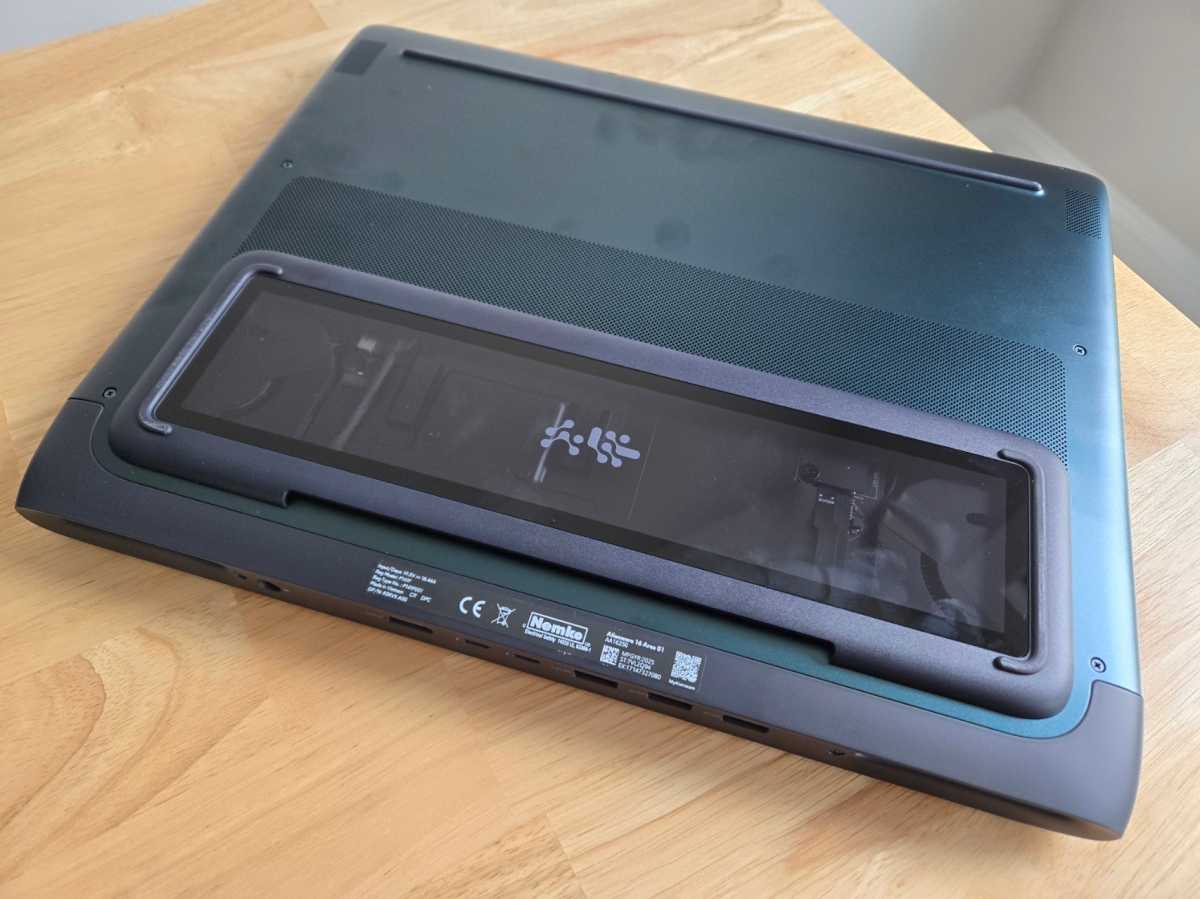
IDG / Chris Hoffman
On the bottom, there’s a “thermal bump” with gorilla glass that isn’t just about airflow intake: it lets you look inside the bottom of the machine. This is the kind of high-end touch you’ll find on this machine. It does look cool!
The anodized aluminum finish does pick up fingerprints a little more than I’d like — something you’ll see in a few of the photos. That’s not unusual, but since we’re talking high-end touches, it’s worth noting.
Alienware 16 Area-51: Keyboard and trackpad

IDG / Chris Hoffman
The Alienware 16 Area-51’s keyboard is absolutely excellent. Our review unit had a Cherry MX ultra low-profile mechanical keyboard. A mechanical keyboard in a laptop is almost unheard of — I think the only time I’ve ever used a mechanical keyboard built into a laptop was when I reviewed another Alienware machine. It’s definitely a tiny bit louder than the usual non-mechanical keyboards, but it’s fairly quiet.
There’s not much room to complain, although I will say that many gamers would probably prefer that the Copilot key wasn’t so large. Located just to the left of the arrow keys, it’s bound to get in the way. Sure, it seems laptops must have a Copilot key these days — but why does the key have to be so wide? Luckily, you can disable it or remap it to another function.
The laptop’s keyboard also has per-key backlighting you can customize. Even the touchpad is an RGB touchpad that lights up when you touch it — and shortly after, so it’s not on all the time. The touchpad itself feels great to use, with a smooth surface, a crisp mechanical clicking action, and a good position below the keyboard.
Alienware 16 Area-51: Display and speakers

IDG / Chris Hoffman
The Alienware 16 Area-51 has a 16-inch IPS display with a QHD+ resolution (that’s 3200×1800) along with a fast 240Hz refresh rate, 3ms response time, Nvidia G-Sync, and 500 nits of brightness.
On paper, these are great specs — and they look great in real life, too. It’s an awesome display that makes games look great, and the fast refresh rate and response time are part of what makes it feel so good. Combined with the speedy hardware, this laptop delivered excellent performance in Doom: The Dark Ages, rendering high detail settings at a high frame rate.
The downsides are the same ones you see on paper. There’s no support for HDR in games here, and the resolution comes short of 4K. This isn’t an OLED—some people will prefer the more vivid colors of an OLED display, even if it comes with a lower refresh rate or lower response time. But, if you aren’t itching for HDR or an OLED display, I think you’ll be happy with this display.
The speakers are also unusually good for a laptop. Many gaming laptops — even expensive ones — cut corners on the speakers. Audio sounded great and punchy in games like Doom: The Dark Ages. Music was unusually good for a laptop, but I’ll be honest: when it came to the clarity of the instruments in Steely Dan’s Aja and the bass in Daft Punk’s Get Lucky, the speakers didn’t wow as much as the other components on this laptop. The experience is always best with a good pair of headphones or external speakers — no surprise there.
Alienware 16 Area-51: Webcam, microphone, biometrics
The Alienware 16 Area-51’s 8MP 3840×2160 camera sounds impressive on paper. And it looks fine in the real world, but it doesn’t wow. Look at a good external webcam. This is more than good enough for online meetings and video chats. But, this being a gaming laptop, I’d plan to get an external webcam if you plan on streaming.
There’s no physical camera privacy shutter, which I know many people like to see.
The microphone setup also just sounds fine to me — it can pick up clear enough audio, but you won’t be getting the kind of crisp, high-quality audio you would with an external microphone. It’s fine, but you’ll always have a better gaming experience with external audio.
When it comes to biometrics, this machine has an IR camera for Windows Hello so you can sign in with your face. As usual on Windows 11 laptops, it worked well. There’s no fingerprint reader here, however.
Alienware 16 Area-51: Connectivity
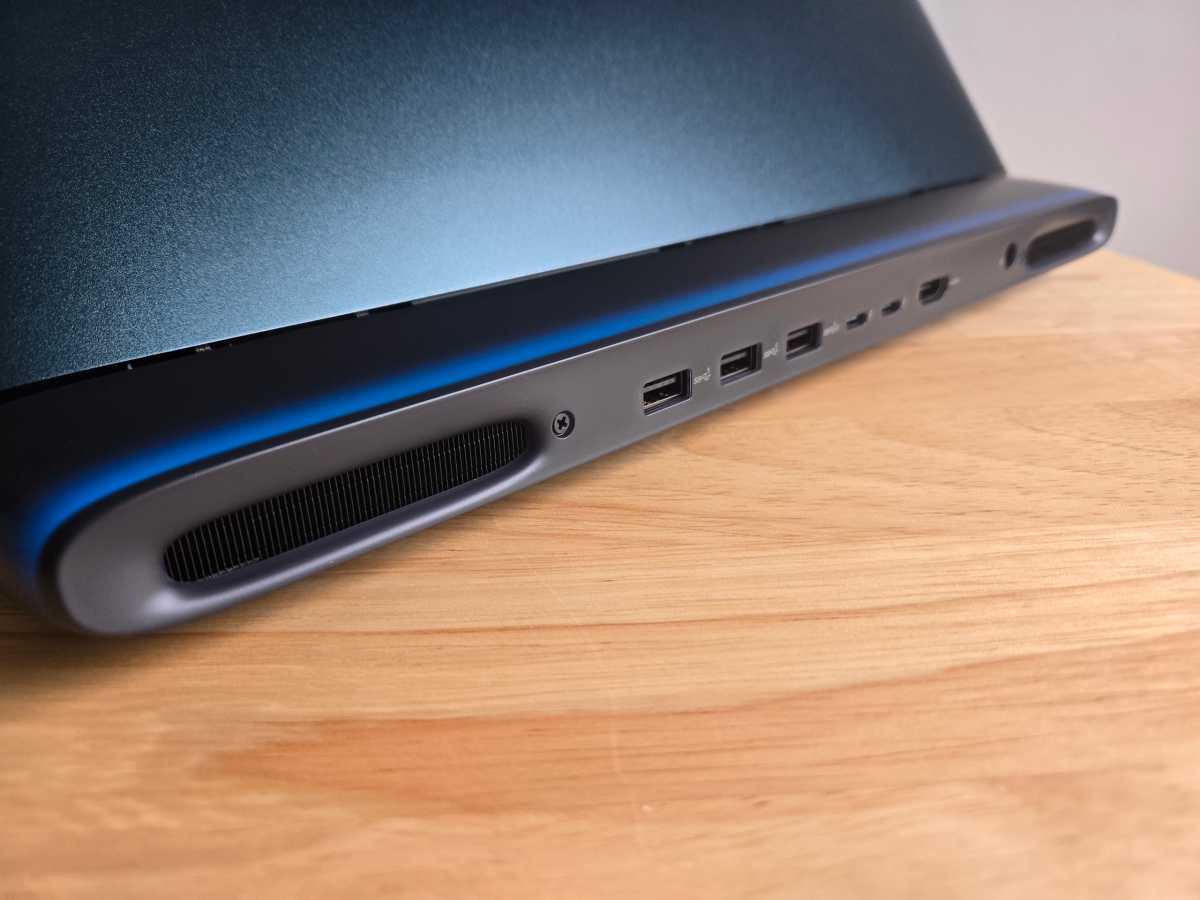
IDG / Chris Hoffman
The Alienware 16 Area-51 has a solid collection of connectivity options. On the left side, you’ve got a combo audio jack as well as a full-size SD card reader.
You’ll find most of the ports on the back — which is where I prefer to see them, as it gets them out of the way of your mouse and minimizes annoying cable clutter on your desk.
On the back of the machine, you’ll find two Thunderbolt 5 (USB Type-C) ports, three USB Type-A ports, an HDMI 2.1 port, and a place to plug in the power adapter. Thunderbolt 5 has been missing in action, so it’s impressive to see it at all — although configurations with an RTX 5070 and below get those ports in Thunderbolt 4 form. While it’s always nice to see higher-end hardware, it likely won’t make a difference in the real world.
On the other hand, that’s it. If you were looking for an Ethernet port, for example, you’ll have to add it via a dongle.
Wireless connectivity is good now that Intel’s hardware has caught up — this laptop supports the latest Wi-Fi 7 and Bluetooth 5.4 wireless standards, and I had no problems with the Wi-Fi.
Alienware 16 Area-51: Performance
The Alienware 16 Area-51 delivered screaming-good gaming performance, and I was tearing through demons in the just-released Doom: The Dark Ages on the highest “Ultra Nightmare” settings with smooth performance. Dell has a lot to say about the “cryo-tech cooling technology” and this laptop’s increased airflow, quieter fans, and all-around improved cooling performance. While gaming, the cooling worked well, with the keyboard staying reasonably cool and the machine blasting most of the hot air straight out of the back where it won’t bother you.
As always, though, we ran the Alienware 16 Area-51 through our standard benchmarks to see how it performs.

IDG / Chris Hoffman
First, we run PCMark 10 to get an idea of overall system performance. With an overall PCMark 10 score of 8,768, this Alienware machine beat other recent gaming laptops we tested with Nvidia RTX 50-series GPUs. It noticeably outpaced the HP Omen Max 16, despite both machines having the same CPU.
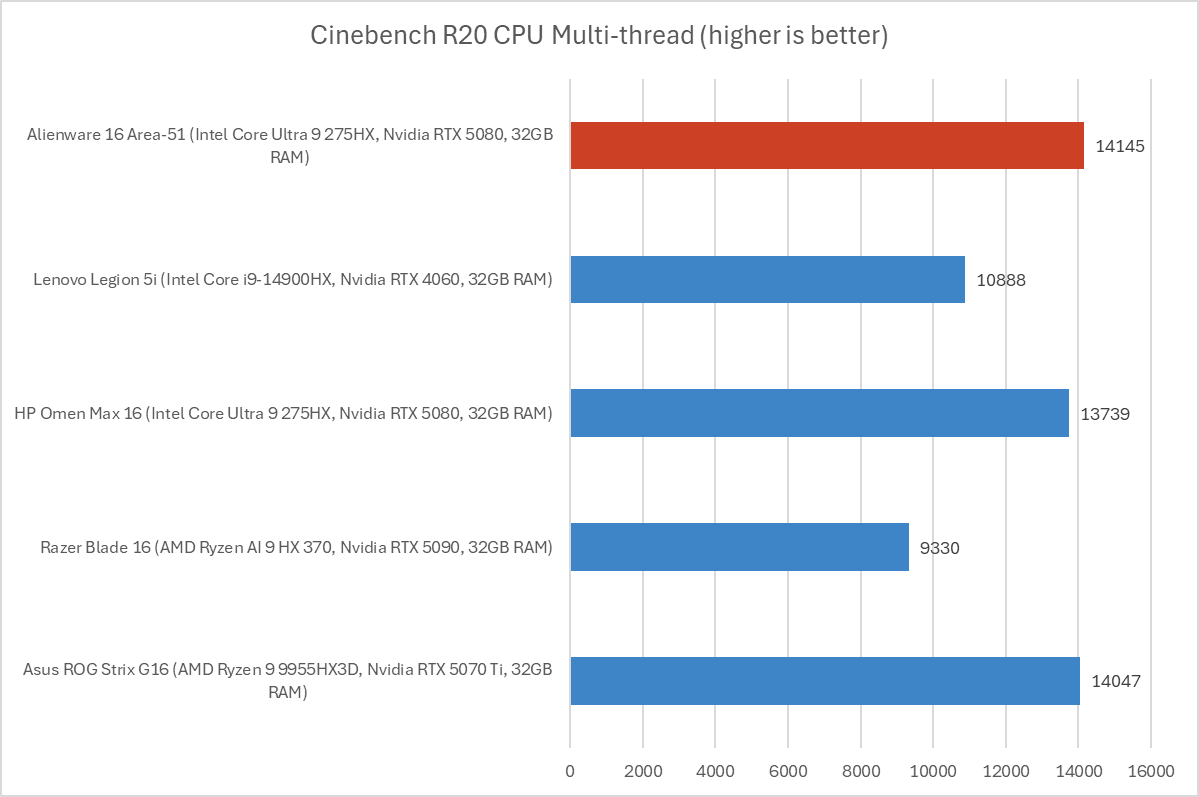
IDG / Chris Hoffman
Next, we run Cinebench R20. This is a heavily multithreaded benchmark that focuses on overall CPU performance. It’s a quick benchmark, so cooling under extended workloads isn’t a factor. But, since it’s heavily multithreaded, CPUs with more cores have a huge advantage.
With a Cinebench R20 multi-threaded score of 14,145, the Alienware 16 Area-51 topped out the charts once again, narrowly scraping ahead of the Asus ROG Strix G16 and its AMD Ryzen 9 9955HX3D. (Although, to be fair, the results are basically within the margin of error here.)
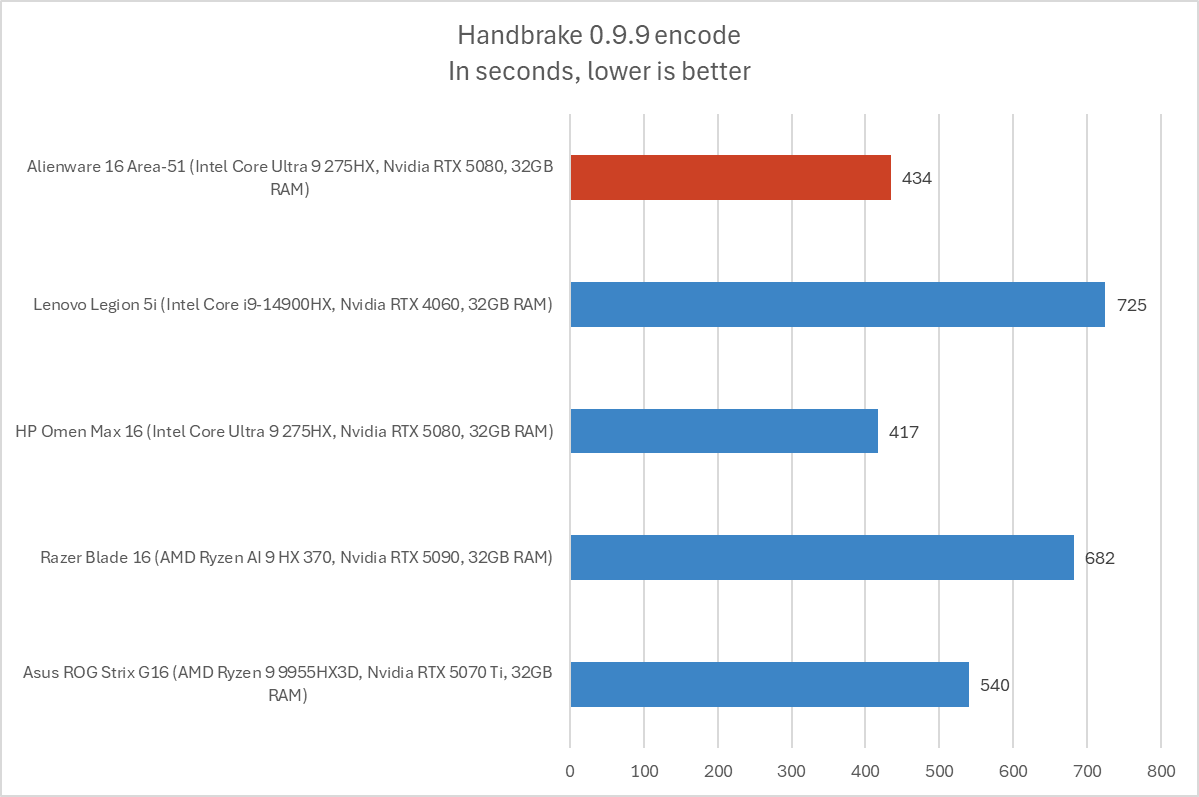
IDG / Chris Hoffman
We also run an encode with Handbrake. This is another heavily multithreaded benchmark, but it runs over an extended period. This demands the laptop’s cooling kick in, and many laptops will throttle and slow down under load.
The Alienware 16 Area-51 completed the encode process in an average of 434 seconds, which is just over seven minutes. The only other machine even within spitting distance was the HP Omen Max 16, which has the same CPU. (HP’s machine was ahead here for some reason, but we can put it down to the margin of error.)
The results show just how powerful Intel’s 24-core Intel Core Ultra 9 275HX CPU is for multithreaded performance. This thing is a beast.
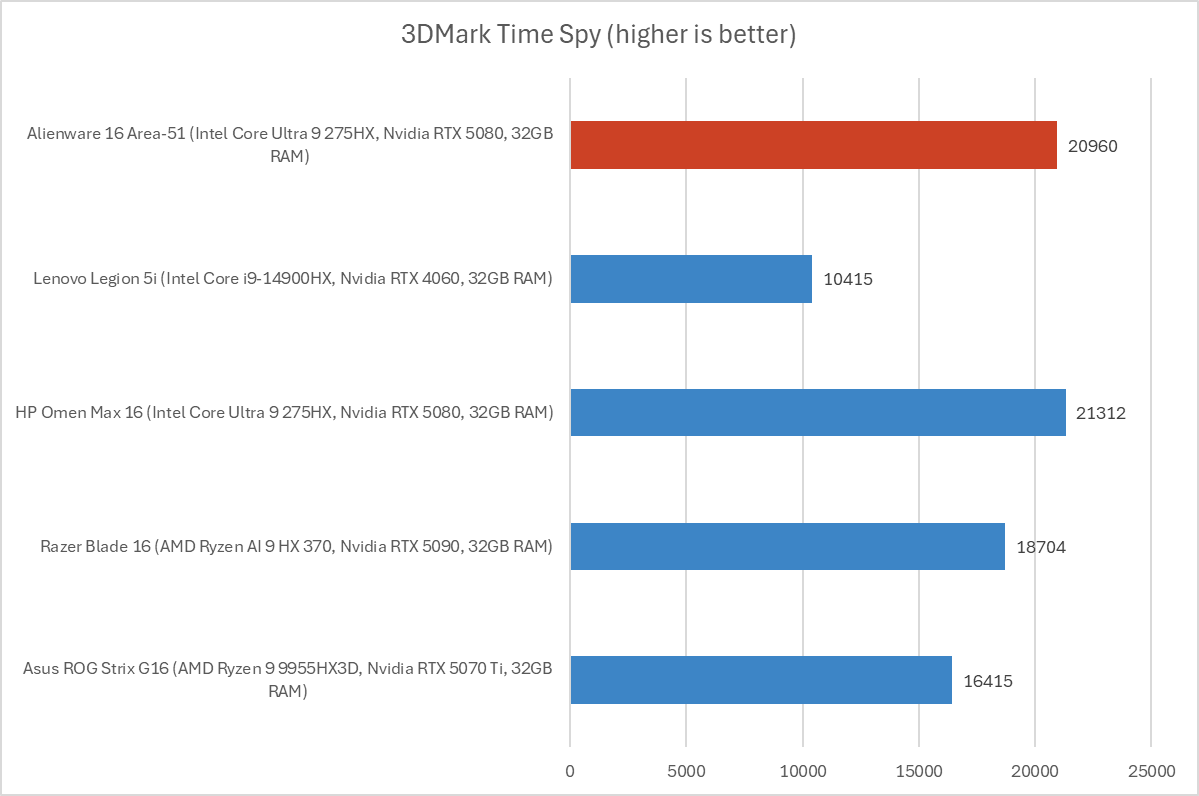
IDG / Chris Hoffman
Next, getting to gaming performance, we start with a standard graphical benchmark. We run 3DMark Time Spy, a graphical benchmark that focuses on GPU performance.
With a 3DMark Time Spy score of 20960, the Alienware 16 Area-51 delivered high performance — coming second to the HP Omen Max 16. Both have the same Nvidia RTX 5080 GPU. Again, this may be the margin of error, or the HP Omen Max 16’s cooling may be a bit more effective.
Both machines beat the Razer Blade 16 despite that machine having a faster RTX 5090 GPU. That machine lags in performance, sacrificing it for a sleeker design. This shows how important benchmarks are instead of just on-paper specs!
After that, we run the benchmarks built into some standard games. First, we use the benchmark in Shadow of the Tomb Raider to test all the gaming laptops we review. It’s an older game, but it’s a great way to compare graphical performance across different PCs.

IDG / Chris Hoffman
With an average FPS of 213, the Alienware 16 Area-51 delivered high-end performance and left many similar systems in the dust.
Finally, we run the benchmark in Metro Exodus. This is a more demanding game, and we set the benchmark to 1080p resolution at the extreme detail setting.
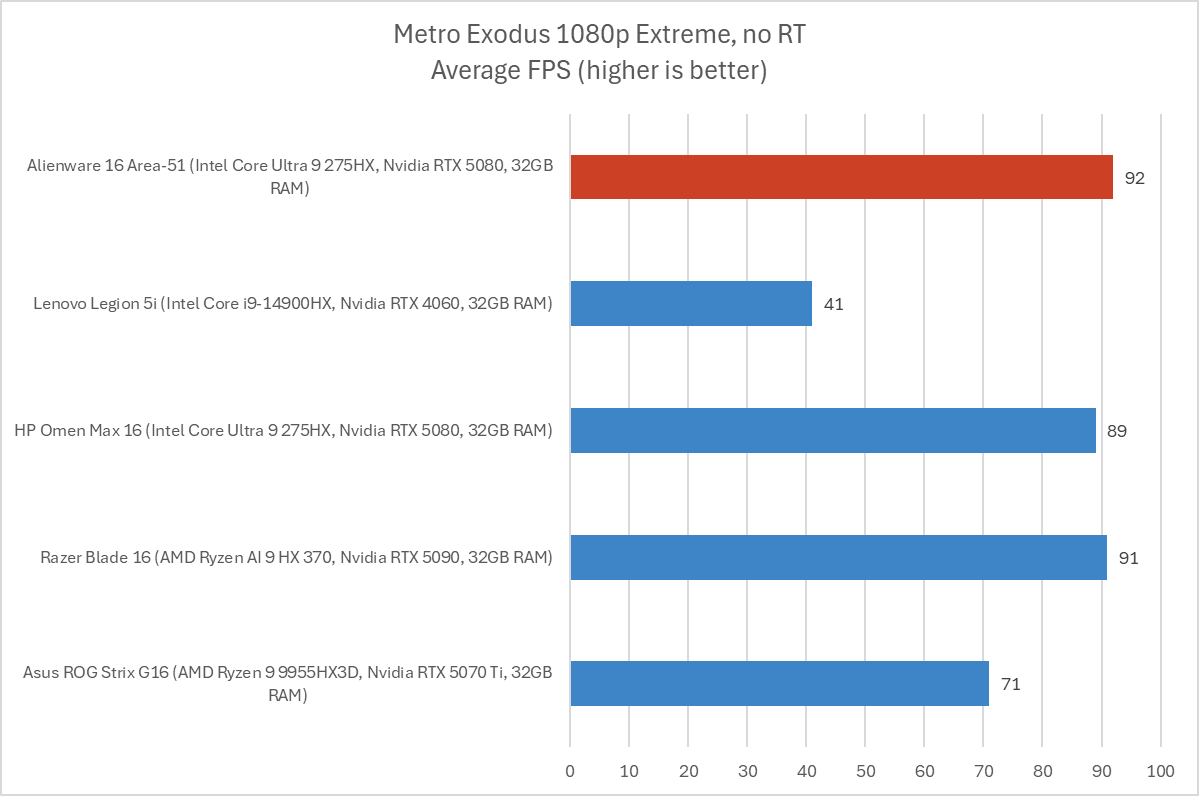
IDG / Chris Hoffman
With an average FPS of 92 in this high-end Metro Exodus benchmark, the Alienware 16 Area-51 topped all its competitors — even the Razer Blade with its RTX 5090 GPU couldn’t outpace it, which just goes to show the downsides of packing such powerful hardware into such a thin machine.
Overall, the Alienware 16 Area-51 is an absolute monster that squeezes an incredible amount of performance out of its high-end Intel CPU and Nvidia GPU. There’s not much room to improve here — outside of splurging for an upgrade to an RTX 5090 GPU in this machine or getting a desktop gaming PC instead!
Alienware 16 Area-51: Battery life
The Alienware 16 Area-51 is a gaming laptop designed for maximum performance, not for long battery life. However, Dell has put a huge 96 watt-hour battery in this machine — it couldn’t be much larger or the U.S. Transportation Security Administration wouldn’t allow it on an airplane.
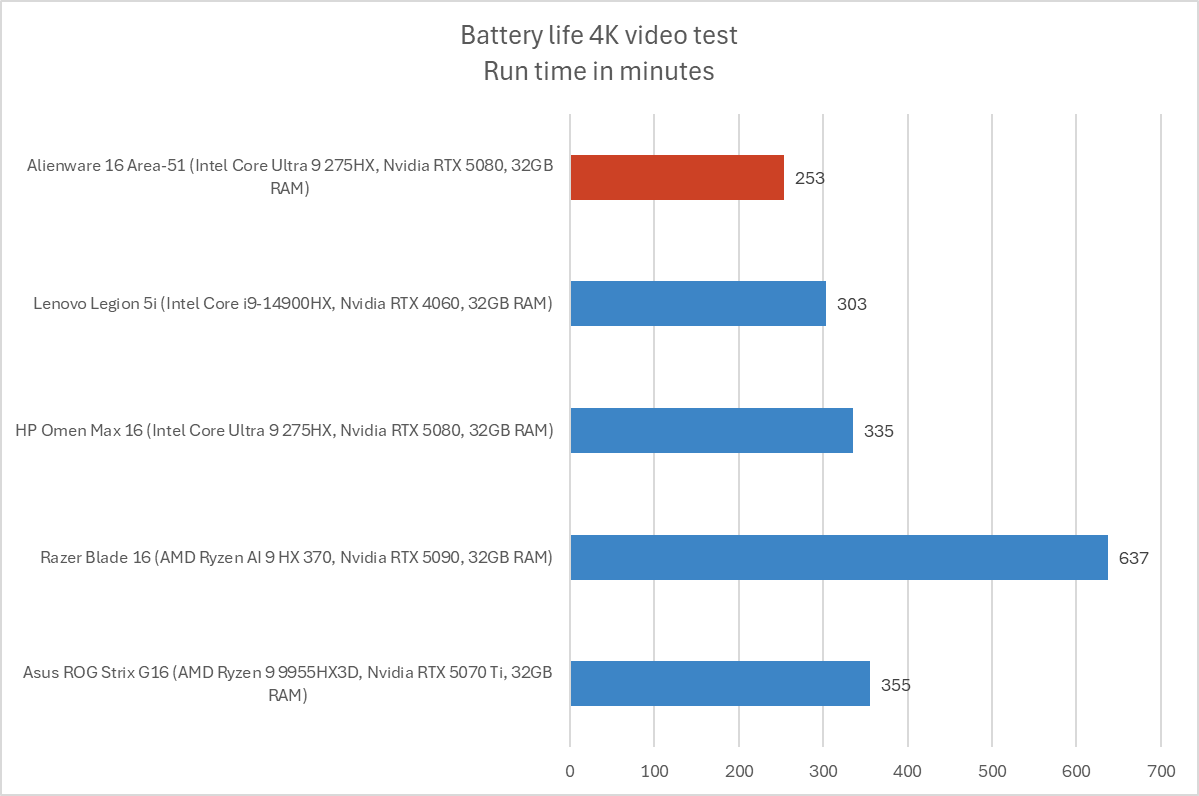
IDG / Chris Hoffman
To benchmark the battery life, we play a 4K copy of Tears of Steel on repeat on Windows 11 with airplane mode enabled at 250 nits screen brightness until the laptop suspends itself. This is a best-case scenario for any laptop since local video playback is so efficient, and real battery life in day-to-day use is always going to be less than this.
The Alienware 16 Area-51 ran for an average of 253 minutes before suspending itself — that’s just over four hours. It’s lower than some of its competitors, though not by much. And that doesn’t really matter if you’re looking for a beefy gaming laptop to use while plugged into an outlet.
In other words, you can use this laptop away from an outlet for a few hours in a pinch, but you won’t want to. Also, it’s worth mentioning that, for serious gaming performance, you need to have the laptop plugged into an outlet anyway.
Alienware 16 Area-51: Conclusion
The Alienware 16 Area-51 is an amazing 16-inch gaming laptop. Yes, it’s a good amount of money — but it’s competitively priced with other high-end gaming laptops with similar hardware, and you also get an amazing package. I love having a mechanical keyboard in a laptop.
If you’re looking for a capable PC with the latest high-end hardware and this fits your budget, you’ll be happy with this machine. It’s excellent.
But not everything is for everyone! Be sure to consider what type of display you want — if you want an OLED screen, the HP Omen Max 16 may be a better pick. That greenish “Liquid Teal” may give some people pause, too — I like the look, but I imagine it’s not everyone’s style. It’d be nice if Dell offered multiple color options for this laptop.